Tranquility debased
 It's been a disconcerting August, trying to re-enter ordinary life after a dream-like fortnight in England and Scotland with Spouse and Daughter. Haven't blogged or done much of anything except catch up on bills and laundry and mope over my dessicated garden. Time for some "serenity now"...so I finally decided to unbox the tabletop fountain I bought years ago for about $5 at a stoop sale. My newly renovated studio space is as unsettled as I am, and could use an "oasis of tranquility."
It's been a disconcerting August, trying to re-enter ordinary life after a dream-like fortnight in England and Scotland with Spouse and Daughter. Haven't blogged or done much of anything except catch up on bills and laundry and mope over my dessicated garden. Time for some "serenity now"...so I finally decided to unbox the tabletop fountain I bought years ago for about $5 at a stoop sale. My newly renovated studio space is as unsettled as I am, and could use an "oasis of tranquility."
Setting out the parts, I realized that combining electricity and water did not make me tranquil. I plugged in the little pump under the faux-slate waterfall, added water and smooth "river stones" (included!), and winced as it screeched to life. The noise subsided and a slick of water gurgled from the top "step" and back into the base. It looked...awful.
 This ridiculous object, crafted in the Number One Chinese Re-Gift Factory, had lurked in the back of my clutter pile, and my mind, as a sort of talisman: When the studio is done, I will create an inspiring corner full of plants, with this little burbling thing tucked in there to refresh my artistic spirit. In classic "toy commercial meets reality" fashion, it was smaller, cheesier, and much less magical than its depiction on the box. As bonsai-scale landscapes go, it was oddly menacing. It reminded me of something. Yes, that's it: Mordor!
This ridiculous object, crafted in the Number One Chinese Re-Gift Factory, had lurked in the back of my clutter pile, and my mind, as a sort of talisman: When the studio is done, I will create an inspiring corner full of plants, with this little burbling thing tucked in there to refresh my artistic spirit. In classic "toy commercial meets reality" fashion, it was smaller, cheesier, and much less magical than its depiction on the box. As bonsai-scale landscapes go, it was oddly menacing. It reminded me of something. Yes, that's it: Mordor!
 Fortunately, we had just the right accessories on hand to create a fitting tableau. No serenity, but at least we enjoyed some warped role-playing with the little fellows. Come on, Mr. Frodo! Just a few more steps!
Fortunately, we had just the right accessories on hand to create a fitting tableau. No serenity, but at least we enjoyed some warped role-playing with the little fellows. Come on, Mr. Frodo! Just a few more steps!
Always on our way to ruin
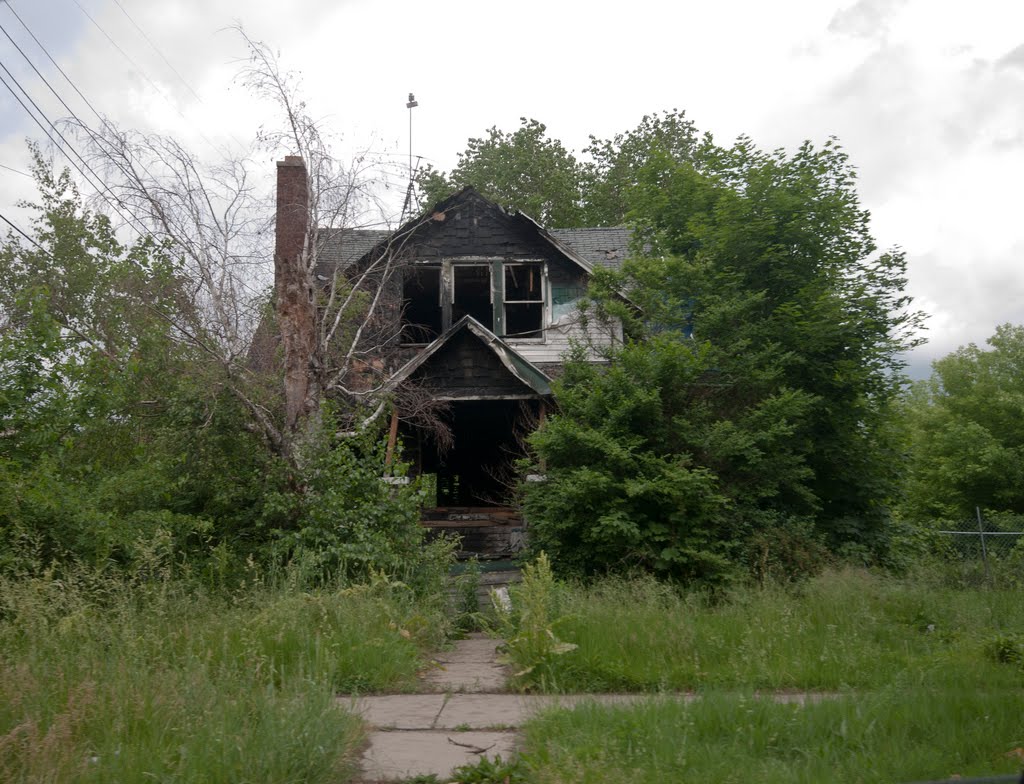 I was going to tell you about how we installed an air conditioner in my new studio so we could prime and paint in a blistering Fourth-of-July-weekend heat wave, but I'd rather share my fascination with decay. In particular, the posting of a new batch of haunting and exquisite "feral house" portraits by the protean Jim Griffioen of Sweet Juniper.
I was going to tell you about how we installed an air conditioner in my new studio so we could prime and paint in a blistering Fourth-of-July-weekend heat wave, but I'd rather share my fascination with decay. In particular, the posting of a new batch of haunting and exquisite "feral house" portraits by the protean Jim Griffioen of Sweet Juniper.
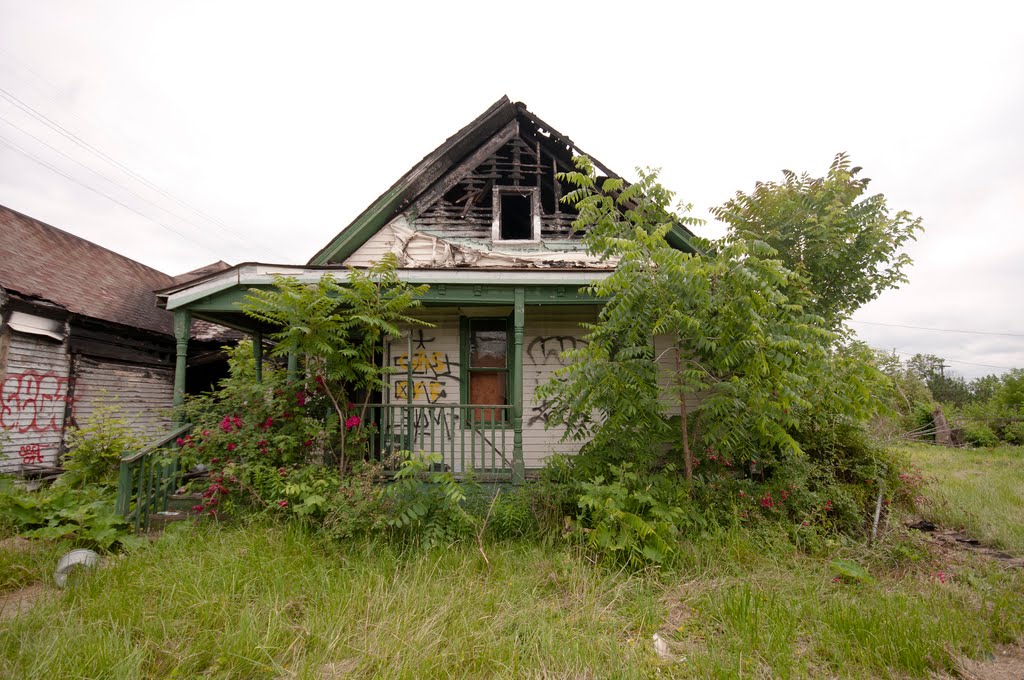 This guy loves his hometown of Detroit with a passion, and writes movingly of its tough and resilient spirit. (He also walks the walk, literally; he's raising his family there.)
This guy loves his hometown of Detroit with a passion, and writes movingly of its tough and resilient spirit. (He also walks the walk, literally; he's raising his family there.)
His riff on house-as-ruin is worth sharing:
I like the idea of the feral as something "beautifully broken"...Building a house, more than any other act of architecture, is what separates us from beasts; even those wild creatures that build crude habitations are never completely sheltered from the elements. Our ancestors, they say, lived in caves, returning at night to those symbolic wombs in the earth. A house has meaning that goes deeper than most of us regularly consider. There is undoubtedly something unsettling about seeing nature invade a home built to keep it out.
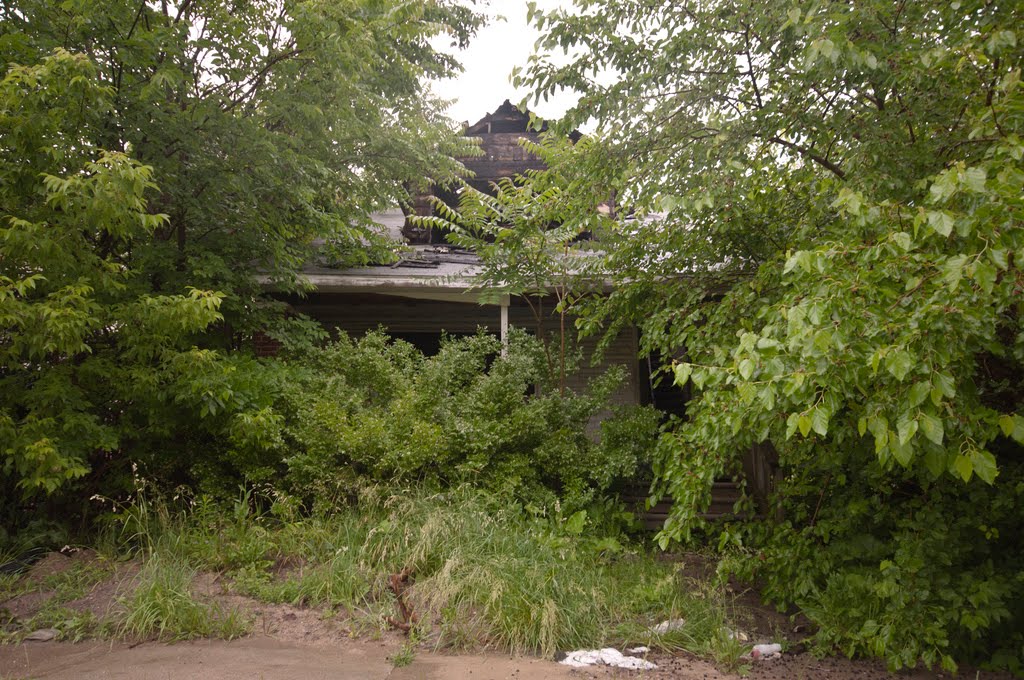 What is a house, really? Isn't it simply raw materials brought together to shelter us from the elements, from the wind and the rain and the bugs? And because they bear those burdens for us, a house is in perpetual decline. Without maintenance, every house is always on its way to ruin. Every homeowner that's ever paid a roofer knows this...
What is a house, really? Isn't it simply raw materials brought together to shelter us from the elements, from the wind and the rain and the bugs? And because they bear those burdens for us, a house is in perpetual decline. Without maintenance, every house is always on its way to ruin. Every homeowner that's ever paid a roofer knows this...
A house is supposed to last longer than us; to see so many returning to earth is a grim reminder that our bodies share the same fate. These houses also represent that liminal state between humans and nature; maybe we aren't as far apart as we think. Maybe we were the first domesticated animals---God's pets---and like these houses we still have it in us to go wild.
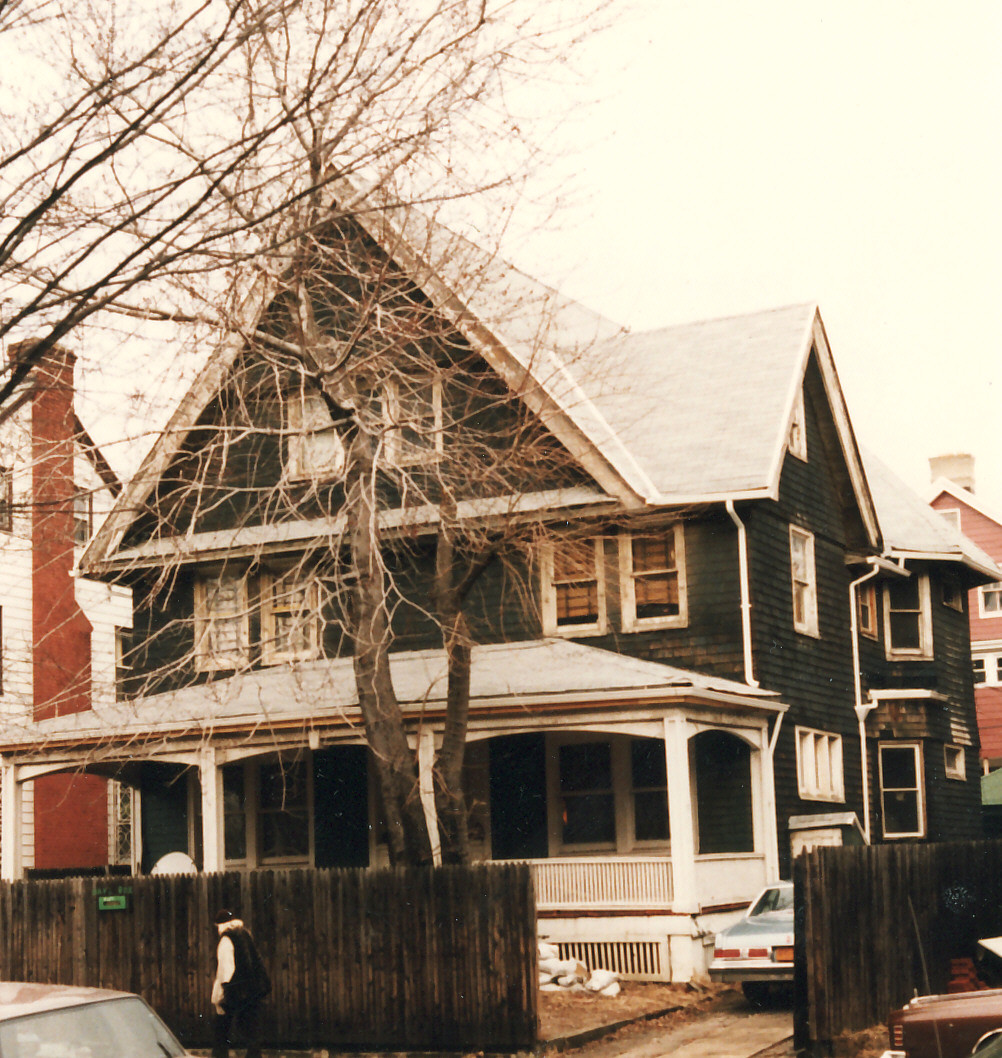
And maybe I find these feral houses so compelling because the Crazy Stable came so close to becoming one. There's the old girl in 1986, getting close to board-up territory. (Yeah, so we don't look that different outside, but there are plenty of domesticated zones within.)
The paint bucket is calling; time to subdue the wilds, a task that never ends.
(Note: Some of Jim's house photos are available as prints here.)
Cloistered climbers
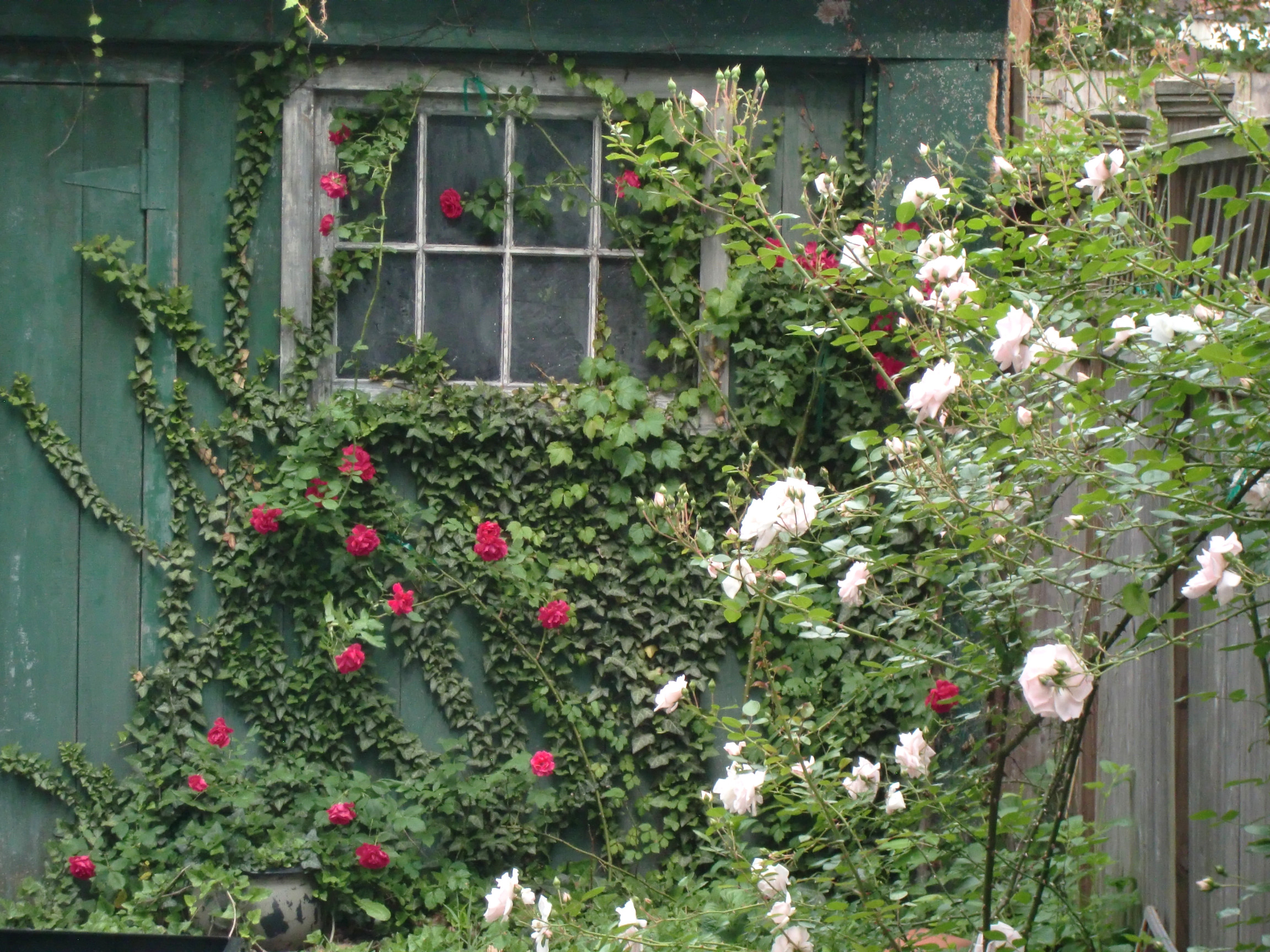 The vision is coming true! Two different climbers are blooming in the "garth," also known as the fenced-off driveway in front of the unused garage. Thanks to the NBC "Law & Order" set makeover, it looks all nice and cottage-y.The red one is Climbing Don Juan (with accidental ivy backdrop), and the pale pink is New Dawn, which I propagated from another New Dawn on the other side of the garden. I am very proud of this.
The vision is coming true! Two different climbers are blooming in the "garth," also known as the fenced-off driveway in front of the unused garage. Thanks to the NBC "Law & Order" set makeover, it looks all nice and cottage-y.The red one is Climbing Don Juan (with accidental ivy backdrop), and the pale pink is New Dawn, which I propagated from another New Dawn on the other side of the garden. I am very proud of this.
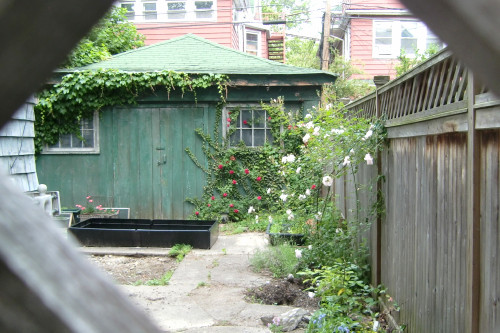 Long shot through the fence lattice shows, at left, how much cement I've ripped up for the raised bed waiting behind it (still needs a tad more chipped off). Even with my compost, I will need many bags of soil to fill it.
Long shot through the fence lattice shows, at left, how much cement I've ripped up for the raised bed waiting behind it (still needs a tad more chipped off). Even with my compost, I will need many bags of soil to fill it. 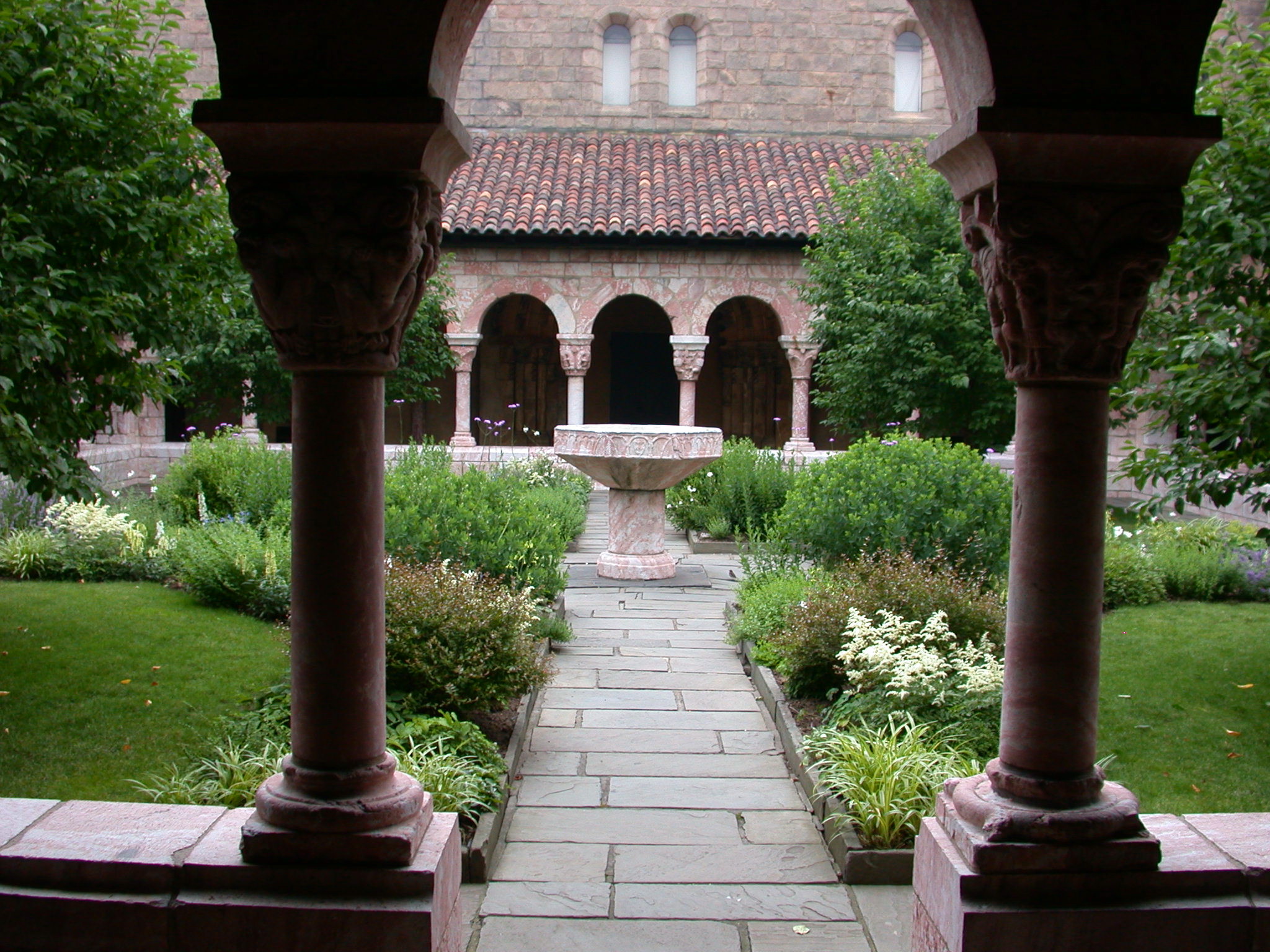 Cracking cement is addictive; I just want to keep going until it's an abbey garden with gravel paths, herb beds, and more flowers (it gets full southern sun). Like the Cloisters, only via sledgehammer.
Cracking cement is addictive; I just want to keep going until it's an abbey garden with gravel paths, herb beds, and more flowers (it gets full southern sun). Like the Cloisters, only via sledgehammer.
Bottom photo: Cuxa Cloister Garden, the Cloisters; Metropolitan Museum
Melancholy, flee!
 Today was the feast of St. Philip Neri, the "patron saint of joy" and founder of the Oratory. Since I belong to the Brooklyn Oratory, I usually mark his feast, but this year was something special; last month, I visited the dear fellow at Chiesa Nuova, his last home in Rome, the city he served humbly until his death at age 80. Here he is levitating. (I like the guys in the doorway: They're like, Whoa! Do Not Disturb!)
Today was the feast of St. Philip Neri, the "patron saint of joy" and founder of the Oratory. Since I belong to the Brooklyn Oratory, I usually mark his feast, but this year was something special; last month, I visited the dear fellow at Chiesa Nuova, his last home in Rome, the city he served humbly until his death at age 80. Here he is levitating. (I like the guys in the doorway: They're like, Whoa! Do Not Disturb!)
 Next to seeing the Holy Shroud in Turin, going to Chiesa Nuova was the biggest thrill of my geeky Roamin' Catholic trip. The church, a splendid Baroque affair called St. Maria in Vallicella, began construction around 1575. Urchins chased a soccer ball on the piazza in front, as they probably have done for a very long time.
Next to seeing the Holy Shroud in Turin, going to Chiesa Nuova was the biggest thrill of my geeky Roamin' Catholic trip. The church, a splendid Baroque affair called St. Maria in Vallicella, began construction around 1575. Urchins chased a soccer ball on the piazza in front, as they probably have done for a very long time.

I think I now "get" the point of Baroque: to make your jaw drop at its sheer fabulousness and thus, believe in the possibility of divine fabulousness. Apparently St. Philip wanted plain whitewashed walls, but wealthy patrons kept piling stuff on. My favorite: this Visitation by Federico Barocci, capturing the intimate shared delight (and slight apprehension) of two unlikely expectant moms.

Golden angels clamber over the organ pipes.
 Beneath them, one enters the gorgeous little side chapel of St. Philip. And I mean...Philip himself. He's in that glass box under the altar (below).
Beneath them, one enters the gorgeous little side chapel of St. Philip. And I mean...Philip himself. He's in that glass box under the altar (below).
As I joined a few other souls for Mass, I tried to focus on anything--the mosaic over the altar, the bits of liturgy I could follow in Italian, anything but the fact that one of my favorite saints, dead for 400 years, was lying a few feet away, in what looked like a giant aquarium, or ant farm. I had seen ant-farm saints in Brazil, and would see several more in Italy, but this was different; I feel as if I know St. Philip personally.
 After Mass, an Oratorian priest led some of us on a tour of St. Philip's rooms. I caught little of his Italian commentary, but it sounded as if this stand-up Philip was used to convince people that he was omnipresent at the Oratory's famous picnics throughout Rome. It has a very Terry Gilliam vibe; I resisted the urge to have someone snap my picture next to it like those cardboard-candidate photo ops.
After Mass, an Oratorian priest led some of us on a tour of St. Philip's rooms. I caught little of his Italian commentary, but it sounded as if this stand-up Philip was used to convince people that he was omnipresent at the Oratory's famous picnics throughout Rome. It has a very Terry Gilliam vibe; I resisted the urge to have someone snap my picture next to it like those cardboard-candidate photo ops.
 The most touching artifacts were Philip's well-worn confessional (he was a legendary confessor and reader of troubled hearts), his battered shoes, a few thin cushions, and a warming box for hands and feet (it was drafty there even in April). I hope Philip's heart, aflame and enlarged with the Spirit, kept him warm; he is sometimes depicted with his collar open to cool off.
The most touching artifacts were Philip's well-worn confessional (he was a legendary confessor and reader of troubled hearts), his battered shoes, a few thin cushions, and a warming box for hands and feet (it was drafty there even in April). I hope Philip's heart, aflame and enlarged with the Spirit, kept him warm; he is sometimes depicted with his collar open to cool off.
 None of this seemed the least bit creepy, not even the saint's death mask. (A little goofy, maybe, but Philip was a joker; he chose mirth over pride and solemnity.) Before leaving Chiesa Nuova, I edged back up to his tomb and stared inside at the elegantly masked and vested body. His feet, shod in velvet slippers, pointed heavenward after their long years of pounding the Roman pavement seeking souls to save. And I felt a stirring breath of consolation regarding old Death himself. Not only did Philip seem deeply at peace within his glass casket, but after four centuries, he remains so vibrantly alive in our Oratory community that his frail remains seemed like an elaborately decorated afterthought.
None of this seemed the least bit creepy, not even the saint's death mask. (A little goofy, maybe, but Philip was a joker; he chose mirth over pride and solemnity.) Before leaving Chiesa Nuova, I edged back up to his tomb and stared inside at the elegantly masked and vested body. His feet, shod in velvet slippers, pointed heavenward after their long years of pounding the Roman pavement seeking souls to save. And I felt a stirring breath of consolation regarding old Death himself. Not only did Philip seem deeply at peace within his glass casket, but after four centuries, he remains so vibrantly alive in our Oratory community that his frail remains seemed like an elaborately decorated afterthought.
Philip used to say, "Melancholy, flee from my house!" I left Chiesa Nuova smiling as a light rain began to fall.
Desperately seeking Denzel
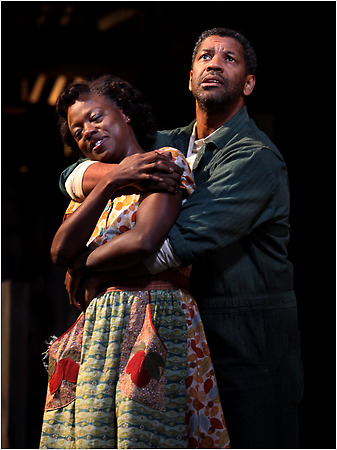 Lucky us: We saw Denzel Washington and Viola Davis in Fences on Broadway. The play was magnificent and so was every actor in it, but then, I was hardly surprised; after all, I gave Mr. Washington his first review (self-satisfied chuckle), and it was a rave.
Lucky us: We saw Denzel Washington and Viola Davis in Fences on Broadway. The play was magnificent and so was every actor in it, but then, I was hardly surprised; after all, I gave Mr. Washington his first review (self-satisfied chuckle), and it was a rave.
Our zero degrees of separation go back to Fordham University's Lincoln Center campus in the fall of 1975, where I spent one freshman semester. He and I were in the same acting class, taught by a wonderful coach named Ed Young. Denzel, a senior, was clearly destined for greater things, and while he was a modest and affable guy (the very opposite of the "big fish in a small pond"), I was far too intimidated by him to suggest doing a class scene study together (oh, say, Othello and Desdemona). (And yes, over 35 years, I have occasionally just smacked my head with a big old brick over that.)
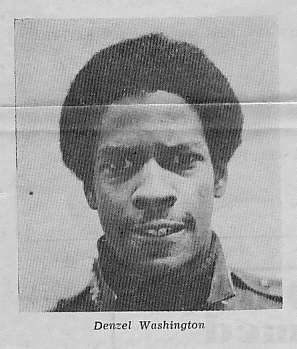 I was supposedly going to be an English major, so I signed up as dance and drama critic for the college paper, the Fordham Review. Denzel, meanwhile, made his stage debut as the lead in The Emperor Jones, Eugene O'Neill's weird and daunting antique written in heavy dialect. He blew it out of the water; already, his confidence and instincts as an actor were astonishing. Here's the heart of my review; can I call them, or what?
I was supposedly going to be an English major, so I signed up as dance and drama critic for the college paper, the Fordham Review. Denzel, meanwhile, made his stage debut as the lead in The Emperor Jones, Eugene O'Neill's weird and daunting antique written in heavy dialect. He blew it out of the water; already, his confidence and instincts as an actor were astonishing. Here's the heart of my review; can I call them, or what?

Over the years, we watched Denzel's star rise with a sort of proprietary delight. (His co-star Paul now apparently owns a balloon business on Long Island.) I fancied the idea of getting the chance to say Hello-I-Knew-You-When; he wouldn't remember me, but he'd remember Ed's class and might get a kick out of it, and I'd get to bask in some delicious homage. Back in 1991 or so, when Spike Lee was shooting "Malcolm X" nearby in Ditmas Park, I dug out a copy of my review and hung around the set. I got as far as his trailer, but it was guarded by a man-mountain in bow tie and shades from the Fruit of Islam, and the idea of nattering about our college connection sort of withered on the spot.
 So last Friday night, I set course for the Cort's stage door. We shot out to the street after the thunderous curtain call...where, perhaps thanks to Tweeting, several hundred fans had materialized across the street to await Denzel's exit, along with mobs from the audience. A staff of at least three handlers and a cop worked barricades, and by the time they were configured for the Big Moment, I was trapped in the armpit of an Amazonian tourist-like female with upraised cellphone camera, three bodies deep into the crowd. Denzel emerged to a cheer and a hail of flashes, convivially signed for about the first 10 folks pressed against the gate, and vanished into his limo as I waved my news clipping (which I had slipped into a folder with a note: "Denzel, I sure got it right"). Foiled again! (I must here observe that, back in the day, Broadway stage doors, even for big stars, were much looser affairs and a fan both lucky and creative could get a surprising amount of access, but no more.)
So last Friday night, I set course for the Cort's stage door. We shot out to the street after the thunderous curtain call...where, perhaps thanks to Tweeting, several hundred fans had materialized across the street to await Denzel's exit, along with mobs from the audience. A staff of at least three handlers and a cop worked barricades, and by the time they were configured for the Big Moment, I was trapped in the armpit of an Amazonian tourist-like female with upraised cellphone camera, three bodies deep into the crowd. Denzel emerged to a cheer and a hail of flashes, convivially signed for about the first 10 folks pressed against the gate, and vanished into his limo as I waved my news clipping (which I had slipped into a folder with a note: "Denzel, I sure got it right"). Foiled again! (I must here observe that, back in the day, Broadway stage doors, even for big stars, were much looser affairs and a fan both lucky and creative could get a surprising amount of access, but no more.)
Hey, it was a great evening...and a wonderful reminder that dreams can come true. I only dabbled in theater, and never became a famous critic, but as we strolled through the neon-flooded canyons on a beautiful spring evening with our willowy daughter, all seemed right with the world.
 But if anyone knows how I can get a package backstage at the Cort, would you let me know?
But if anyone knows how I can get a package backstage at the Cort, would you let me know?
Photos top and bottom: New York Times